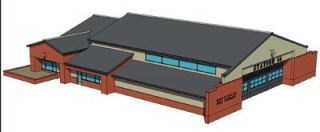MARYSVILLE A new firehouse is in the works for the southern end of town.
The Marysville Fire District will be assuming responsibility for much of the newly annexed Sunnyside and Whiskey Ridge areas after Marysville added the neighborhoods last December.
Currently the Lake Stevens Fire District covers the areas stretching east to SR 9, but the Marysville Fire District will take over after 2007. The district is a separate legal entity from the city, but shares three City Council members on its board of directors. The city has a 26-acre parcel of land and will sell the district a couple of acres to host the 10,000-square-foot firehouse.
Until it is built the Marysville Fire District will contract with the Lake Stevens Fire District to cover the area. Marysville Fire Chief Greg Corn expects the $2.5 million structure to be finished in about a year.
We hoping by mid-year in 2008, Corn said. We were actually hoping sooner but the reality is more like 2008.
The new station will have three bays but initially will hold a response team of an engine and an aid car. It will be staffed by a three-person crew, but as the area is built up more units and staff are likely.
The station is needed because the nearest Marysville firehouse is Station 61 in the heart of downtown at the Marysville Public Safety Building on Grove Street. Access times from Grove via 67th Avenue, 83rd Avenue or Sunnyside Boulevard are just too long for Corn.
For us to serve them it would be more like 11 minutes. Lake Stevens is closer to seven minutes, he said. We should be able to get to most of the area out there within five minutes from that location.
The station is planned for the intersection of 40th Street NE and 71st Avenue NE. The size and cost of the station are subject to change as plans are still in the works. The district filed for a conditional use permit last week and the project will have to go before the Marysville Hearing Examiner, according to Corn.
The fire district has had the money to build the station in its capital projects fund for some time, but could not afford to staff the station until voters approved a levy lid lift at the ballot last fall. The district gets property taxes but does not receive any of the impact fees levied on new residential or commercial construction cities, counties and school districts do.
Build it right and we will come
Corn said the district is crossing its fingers in hopes that builders and the county will come to an agreement on air condos, a dense form of housing that crams single-family residences in so tight that many firefighters fear they could not get their equipment to a fire. The planned communities have narrow roads running through them, but because they are on private property they can be narrower than city or county streets. That can be a problem for large fire trucks, especially ladder companies.
Compounding the problem is the lack of parking in these developments. Some are building two-car garages with cars nose-to-tail, and with only one visitor parking space for four residential units, according to one district official. Take a two-income family, add a couple teenagers with their own wheels and there will be crowded streets with cars everywhere.
One of the main things we would like to assure is access to them and thats via the roads that are installed in them. They provide very little parking, leaving people the only place to park on the street, Corn explained. Then the county doesnt has enforcement authority because its private property. And then we cant get in.
Builders argue that the homeowners association has authority to tow cars blocking streets, but Corn said thats not likely to happen when the president of the homeowners association lives right next to his association members.
The fire marshals also dont like the close spacing between units. Even with many modern building materials, there is still a significant danger of fire jumping from building to building, especially tongues of flame licking at the eaves of buildings, where air vents allow hot air to shoot into a neighbors attic. Another concern is that firefighters wont be able to get ladders propped up between houses. Fire codes require each bedroom to have a window for emergency egress and those are usually on the sides of the houses in the developments. Corn said his peers have asked that if the builders put houses so close together, to have them put the windows on another side.
We cant ladder those windows between those buildings, he said.
The city of Marysville comprises less than a third of his district by footprint but it is the most dense part of his 55-square-mile service area. Last year the Marysville City Council put a moratorium on the low-density, multi-family residential developments, as they are officially known, and tweaked the rules to the firefighters specs. Not only are the buildings and plans a better fit, but the conditions of the building or occupancy permits give firefighters the upper hand on parking matters.
If they do get plugged up, then we have the authority to tow, Corn said.
One fire official said he thought the pendulum is swinging back toward safety versus density, as builders try innovations to provide more affordable housing to the many residents moving to Snohomish County. Corn said he hopes that is true.
We know they are coming, Corn said. While we may not like them, what can we do to make them work.
Mville Fire District plans new Sunnyside station
MARYSVILLE A new firehouse is in the works for the southern end of town.



